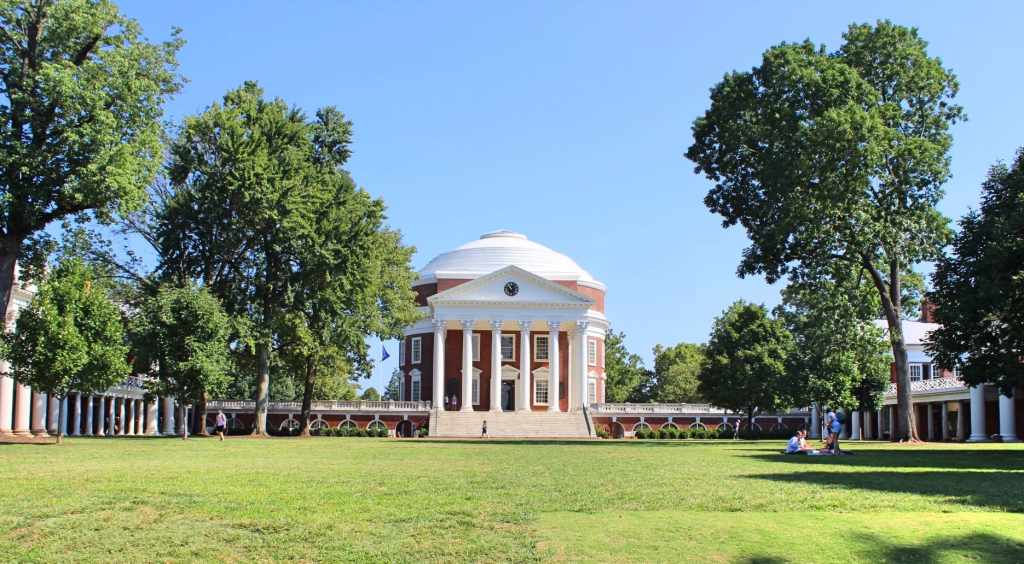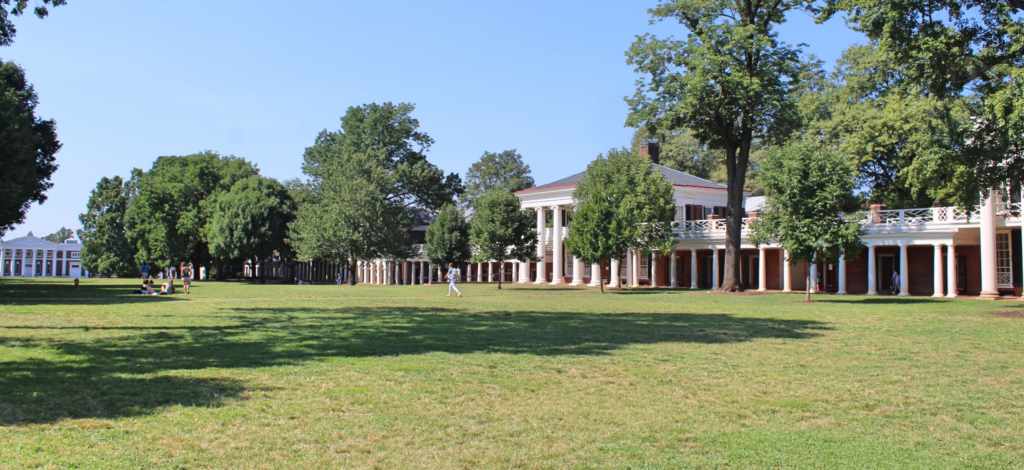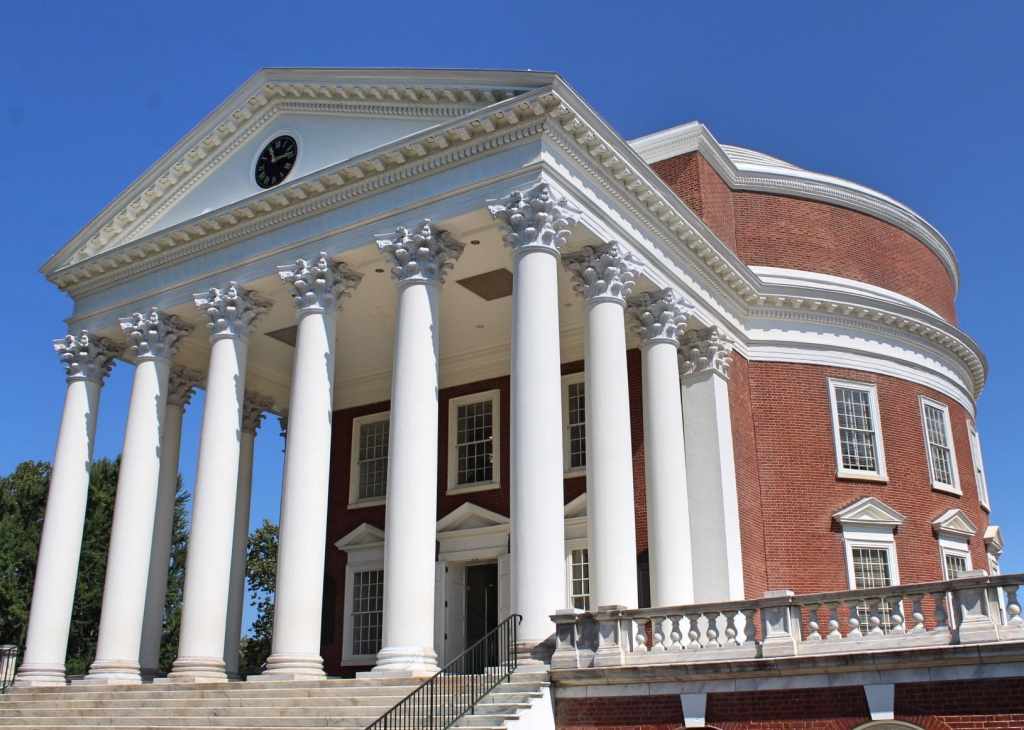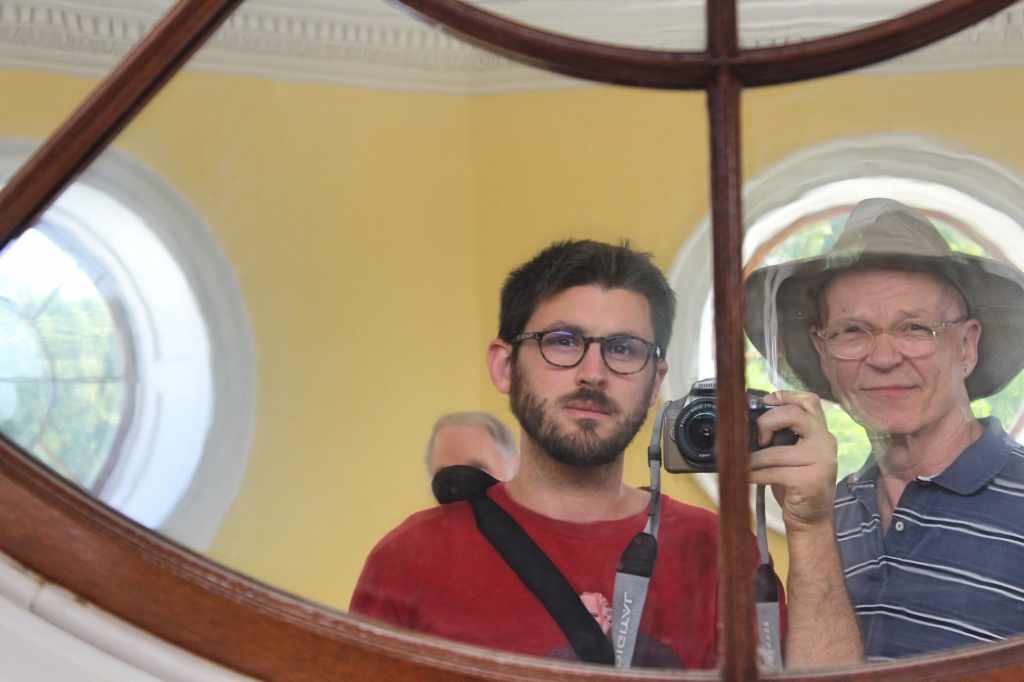Thomas Jefferson is an American icon. Virtually every American can recite (or at least recognize) the immortal lines penned by Jefferson, declaring our independence: “We hold these truths…” His face graces the nickel, and his likeness scowled from the now-defunct $2 bill. A veritable Greek temple stands devoted to his form and memory in the nation’s capital; and, in the Black Hills of South Dakota, Jefferson is chiseled into a mountain-side. And yet, if you really want to pay tribute to this foundational father, you must make your way toward the Blue Ridge Mountains of Virginia, to Charlottesville.
In the summer of 2019, my family did exactly that. On the drive down from New York, we even decided to listen to Jon Meacham’s worshipful biography of the man. Unfortunately for us, the book failed to make a good impression; and, as it so happened, Jefferson similarly failed. But I am getting ahead of myself.
This was my first time in Virginia. The summer sun beat down hard, making the rolling fields of grass glow an iridescent green. A friend of my father owns an alpaca farm in the nearby town of Gordonsville, which we visited before dinner, giving me the briefest taste of farm life—new to me.

That night, after dinner, my brother and I wandered into downtown Charlottesville. As we did not wish to visit a bar, there was little to do but walk. But we did happen upon the statue of Robert E. Lee, which has been the center of so much controversy. A 2016 proposal to remove this Confederate monument sparked the now-infamous Unite the Right rally—in which one counter-protester died, and which Trump refused to condemn. After this, the City Council voted to remove the statue; but the state government overrode this decision, and the strange commemoration of a rebel racist stands to this day.
If I had been more aware at that moment, perhaps I would have realized that this embattled statue was only the most visible manifestation of the region’s contested history. The Confederacy may have been defeated, and slavery long abolished; but in Charlottesville, history is still an active warzone. And nowhere is this struggle more apparent than in the town’s most famous resident, Thomas Jefferson.
We parked the car in the garage and walked onto campus. Charlottesville is, above all, a college town, and that college is the University of Virginia. This university was founded by Thomas Jefferson himself, in 1819, and the place still bears his distinct thumbprint. Jefferson designed the buildings—now a UNESCO World Heritage site—and designed the curriculum and sat on the original Board of Visitors. Indeed, the university is arguably the most complete expression of Jefferson’s intellectual vision.
As it happened, we arrived in the university’s central building—the Rotunda—right at the commencement of a free guided tour. Naturally, our guide told us a little bit about this building first. A dedicated Neoclassicist, Jefferson modeled his design after the Parthenon, as well as works by the Renaissance architect Andrea Palladio. But Jefferson’s use of red brick gives the building a distinctly American stamp. Just as significant as the building’s form is its function: it housed the original university library. This is an obvious and significant deviation from the traditional, medieval model of a university, centered on a church. Indeed, Jefferson’s plan was so insistently secular that he did not even want theology or divinity taught to his pupils. This elegant building was severely damaged by a fire in 1895, during which a group of enterprising students saved a marvelous life-sized statue of Jefferson by pushing it onto a table and carrying it out together. Jefferson’s spirit would have thanked them if he had believed in the afterlife.


Extending outward from both sides of the Rotunda, like two arms, are the parallel rows of buildings that enclose the Lawn. These are the ten Pavilions (five per side), where faculty reside and teach. Nowadays, professors only live in these Pavilions for three to five years, and rotate to allow for fresh faces; but in Jefferson’s original idea, the faculty would stay here long-term and live among the students. Even now, the resident faculty are expected to socialize with the students, 54 of whom stay (during their senior year) in the prestigious “Lawn rooms” that flank the Pavilions. On the other side of the Pavilions are gardens; and beyond that, the Range, for graduate students. The idea is both idealistic and charming: Jefferson imagines a kind of open-air community of scholars, living amid architecture that inspired the mind. Indeed, each of the ten Pavilions bears a distinct, Neoclassical design, the idea being that the ensemble would be a kind of visual catalogue of architectural styles.

On the whole, I found the Academical Village to be greatly appealing. I would love to wake up in one of those quaint little rooms, sit outside on my rocking chair, under the colonnade, reading some book, and waving casually to my passing professors. Few places I have been so perfectly evoke the gentile life of the mind—the elevation of beauty, truth, and goodness over all petty practical concerns. This picture contains a large dose of fantasy, unfortunately. The first batches of scholars were rowdy, spoiled, wealthy boys, who drank and partied and played pranks on their professors. More significantly, it is worth remembering that these buildings, gardens, and manicured lawn—not to mention the entire economical system—was built by slave labor. And though students could not bring their own slaves, professors could and did. To the rosy image of intellectual freedom, then, we must add the violence of human bondage.

Just as our tour of the university was coming to a close, our tour of Monticello, Jefferson’s old plantation, was about to begin. Now, Monticello literally means “little mountain,” and the name is perfectly sensible, as the house stands on a hill overlooking the surrounding area. We drove up to the visitor’s center (which has a café and a gift shop), and then hopped on the shuttle bus up to the house for our tour. Monticello can only be visited on a guided tour, which took around two hours. No photos are allowed inside, but the website includes a wonderful virtual tour, which is far better than this measly blog post.

I will hardly bother to describe the exterior of Monticello, since if you have seen a nickel you know what it looks like. Suffice to say that it is built in the same Neoclassical style, with the same red brick, as the buildings of the university. Indeed, Monticello could be transported to the center of the University of Virginia and look perfectly at home.
The house is entered, logically enough, through the front door, which leads directly into the entrance hall. This room is decorated with all sorts of artifacts from Lewis and Clarke’s epochal journey into the American wilderness—horns, antlers, Native American artifacts, and even the mandible of a mastodon. (According to Meacham, Jefferson’s attitude towards Native Americans was only slightly more enlightened than his contemporaries, thinking them not racially but culturally inferior. In any case, he still had no qualms about taking their land.) There are also many busts on the wall—including one of Voltaire, and another of Jefferson’s rival and nemesis, Alexander Hamilton. I suppose Jefferson liked his enemies close.
Most conspicuous of all might be Jefferson’s Great Clock. It has two faces, one facing outward, which only shows the hour (accurate enough for slaves, Jefferson thought), and another facing inward, with a minute and a second hand. It is quite a contraption. The clock is connected to a gong outside, which chimes out the hour loud enough for the whole plantation to hear. It works via a series of weights, which look like cannon balls. The clock is wound up at the beginning of the week (Sunday), and the falling weights mark the day as well as keep the hour. Unfortunately, the clock was designed for a somewhat more ample space, and so the last day of the week (Saturday) is located in the basement.
As one moves through Monticello, the visitor gets a greatly paradoxical impression of Jefferson. He was, for example, both provincial and cosmopolitan. Not remarkably well-traveled himself, he read voraciously about other lands (such as in the journals of Captain James Cook), and kept up a correspondence with contemporary explorers like Alexander von Humboldt and Meriweather Lewis. On the other hand, he was himself something of a homebody, keeping close to Monticello (after his return from France) and even founding his pet university in his backyard. In terms of taste, Jefferson improbably wants to combine a kind of rural simplicity with an enormous mansion and French style, making the house seem both luxurious and homely.
Another contradiction is between Jefferson’s genius and his dilettantism. His library spans dozens of academic disciplines, and yet his manner of organizing books, plants, and correspondence is entirely homespun. Monticello is a work of architectural brilliance; but the windows awkwardly span both the first and the second floor, meaning that they do not align with eye level. The clock may epitomize this contradiction best: an ingenious device for which Jefferson had to bore a hole through his own floor. The biggest contradiction of all, of course, is that the self-proclaimed champion of freedom lived in a slave plantation. But I will return to that.
From the entrance hall, the visitor quickly moves to Jefferson’s living quarters. His working life centers upon his library and his “cabinet” (or, study), which are filled with dusty volumes, the busts of famous men (like his frenemy, John Adams), and scientific instruments, such as his telescope, barometer, or theodolite (a surveying instrument). Both rooms overlook Jefferson’s greenhouse, where he grew exotic plants. The quaint quality of Jefferson’s mind is quite apparent here. He had a five-sided writing stand commissioned and built, so that he could display different documents and books (though a simple table seems more practical to me). On his desk stands a bygone innovation, the polygraph, which uses a mechanical arm holding a pen in order to duplicate letters (and Jefferson was a prolific correspondent). Jefferson did not invent the device, but he tinkered with it, and was quite enthusiastic about its use. The most idiosyncratic touch may be Jefferson’s bed, which is built into the wall between his study and bed chamber. The arrangement does save space; though for a man of 6’2’’, the bed seems quite snug.
My favorite room in the house was perhaps the parlor, where Jefferson did much of his entertaining. The room has a high ceiling and an unusual geometry. Opposite the main doors (hooked up, under the floor, so that both sides open and close in tandem), there are two pairs of tall windows and a single glass door, all looking out at the back garden, which serve to make the room sunny and bright. Two pianos and a zittern (similar to a lute) sit ready for music-making; Jefferson himself took part on the violin. Most attractive, for me, were the many portraits covering the walls. A somewhat unusual painting of George Washington stands near the famous Mather Brown portraits of John Adams and Thomas Jefferson, made while the two men were overseas, with Jefferson looking distinctly more foppish than usual in his big white wig. On another wall hang three portraits of Jefferson’s intellectual heroes: Francis Bacon, John Locke, and Isaac Newton—all unabashed champions of empiricism.
I do not wish to get bogged down in a room-by-room description of Monticello, but I must mention some highlights. One of Jefferson’s innovations were double windows, which let in light but provide for more insulation, since the air between the glass acts as a buffer. The dining room is equipped with a dumbwaiter to bring up wine from the cellar (Jefferson liked French wine), to minimize the number of servants (read “slaves”) needed for his guests. An octagonal bedroom on the ground floor—with another alcove bed—is called the “Madison room,” since this was where that other founding father stayed on his frequent visits. Upstairs (and the stairs are very steep and narrow, another oddity of Jefferson’s design) there are mainly bedrooms, for Jefferson’s sister, daughter, and grandchildren. The tour culminates with the dome room—also octagonal, as apparently Jefferson loved the shape—on the third floor, which provides a commanding view of the surrounding area.

But now we must leave the house of Monticello itself, and explore the grounds of the estate. For here is where the history of Monticello becomes decidedly less charming. Monticello was not simply a residence, but a plantation, wherein enslaved men and women worked to enrich Jefferson. This was done by growing and selling crops—tobacco and wheat, notably—as well as by producing goods for sale, such as nails. On the road running past the house, dubbed Mulberry Row, stood the small residences of these enslaved workers, many of whom labored alongside white contract laborers to construct the house. Some of these still stand, or have been reconstructed. One of the latter is the cabin of John Hemmings, a literate carpenter who was one of the few enslaved people to be freed by Jefferson.

The contrast between elegant finery of the mansion, and this simple little dwelling, is almost gut-wrenching. That the man who declared that liberty was an inalienable right, that all men were created equal, could own fellow human beings and live by the violent coercion of their labor—it is simply too paradoxical to swallow. One naturally at least hopes that Jefferson was an especially “good” or “enlightened” slave-owner, whatever that would mean. But even that is not the case. Jefferson owned 600 different people during the course of his life—about 100 at any one time—and he treated them much as his neighbors did: namely, by giving them the choice between work or physical punishment. Husbands and wives were separated, as were mothers and children; and Jefferson ordered his overseers to beat enslaved people on multiple occasions. This should hardly need stating: Slavery requires violence to exist, and is itself a form of violence. There is no nice way to own a person.

One cannot even take comfort in the fact that Jefferson was distant from the real management of his estate, like some dreamy philosopher absorbed in his pursuits. Slavery was at the core of his life. After his wife passed away, Jefferson began a sexual relationship with his wife’s half-sister, an enslaved woman named Sally Hemings. Indeed, this “relationship”—if that is what it should be called—likely began when Hemings was still an adolescent. And while we do not have much notion of how the young Hemings felt, it is difficult to call such sex “consensual,” considering that Jefferson was much older, not to mention her legal owner, as well as the owner of much of her family. Sally Hemings had six children by Jefferson, whom he owned until his death, freeing them in his will. Evidently, slavery could not have been a more intimate part of Jefferson’s life.
The tour ends with a walk down back to the visitor’s center. On the way, you pass by the Monticello Graveyard, where Jefferson himself is buried along with many members of his family. His own tombstone—tall, but not grandiose—bears an epitaph he wrote himself, mentioning three accomplishments: that he wrote the Declaration of Independence and the Statue of Virginia for Religious Freedom, and that he founded the University of Virginia. Anyone familiar with his life will immediately notice that it omits arguably his greatest accomplishment: serving as President. But Jefferson was very mindful of his image, and strove hard to preserve his aura of the humble, unworldly intellectual; and so I think the epitaph is very much in keeping with this persona.
Further on, down near the parking lot, is a fenced off area. This was a burying ground where at least 40 of the enslaved people of Monticello were buried, though you would never know it if not for the sign, as there is not a tombstone to be seen. Once again, the contrast speaks for itself.
Though Jefferson is buried on the property, his family soon lost it after his death. For all of his brilliance as an intellectual and a politician, Jefferson was not a good businessman, and died hopelessly in debt. The house—including the vast majority of the enslaved workers—was sold after his death to pay off these debts. Luckily for posterity, the property was bought by an admirer of Jefferson, Uriah P. Levy, who preserved the house. Monticello is now owned and run by the Thomas Jefferson Foundation, which I think does an excellent job in telling the story of this place. Every aspect of this complex man—from his scientific pursuits to the reality of slavery—was explained with honesty and care.
The Thomas Jefferson Foundation does not attempt to resolve the conflicts inherent in the life and legacy of the third president. Nor will I. Indeed, there is no way to resolve the paradox: Jefferson was a champion of freedom and a slave-owner. He was a man of life-enhancing brilliance who participated in one of history’s most monstrous institutions. His words epitomized some of our finest aspirations, while his actions embodied our basest impulses. I do not think penning the Declaration of Independence can somehow cancel out the violence inflicted on 600 human beings. Morality does not work like that. If he were brought back from the dead, we would have to award him the Nobel Prize and then throw him in prison for the rest of his life.
For this reason, we left Monticello just as appalled as inspired by Thomas Jefferson’s life. His legacy is perhaps most valuable, then, as a reminder that high ideals on paper can and do coexist with ugly realities in the world. This, after all, is just as true of the story of America as it is that of Jefferson. We should not make the same mistake as Jefferson in thinking that we can politely express our disapproval of an oppressive and unsustainable system while profiting by it and doing nothing to change it. Even now, almost two centuries after Jefferson’s death, there is still much work to be done.
